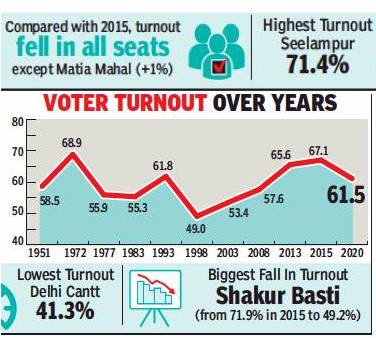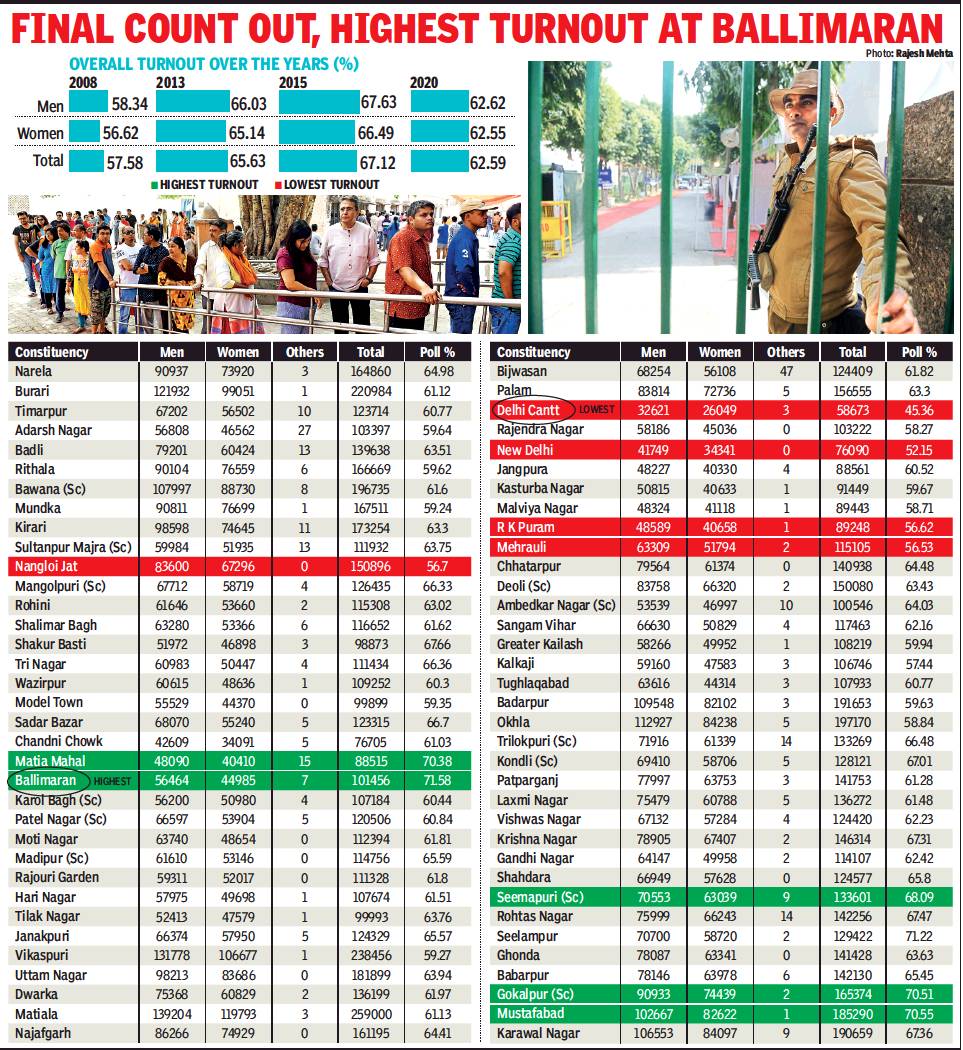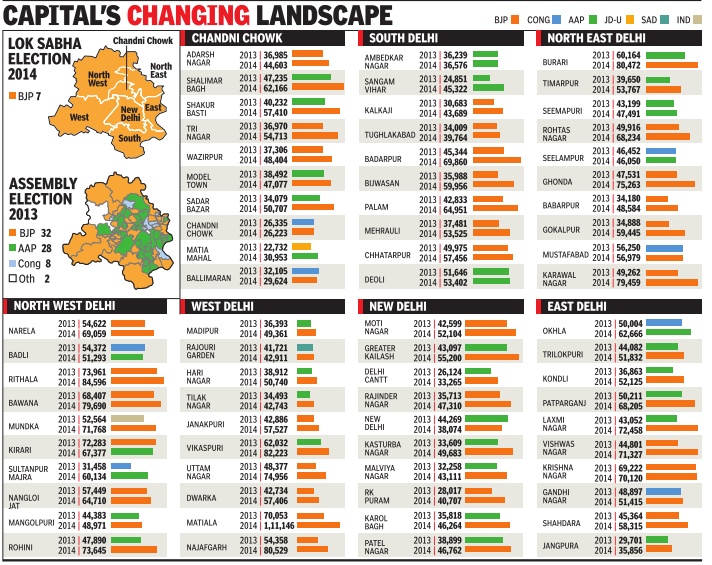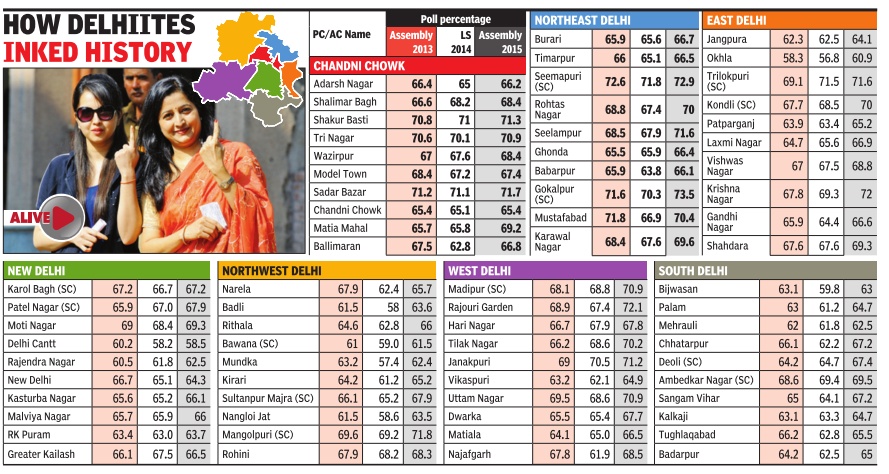Delhi: Assembly elections
(→YEAR WISE DEVELOPMENTS) |
(→1951-2020) |
||
| Line 10: | Line 10: | ||
= Voter turnout= | = Voter turnout= | ||
==1951-2020== | ==1951-2020== | ||
| + | [[File: Voter turnout in elections to the Delhi legislative assembly, 1951-2020.jpg| Voter turnout in elections to the Delhi legislative assembly, 1951-2020 <br/> From: [https://epaper.timesgroup.com/Olive/ODN/TimesOfIndia/shared/ShowArticle.aspx?doc=TOIDEL%2F2020%2F02%2F09&entity=Ar00308&sk=3C70E954&mode=text February 9, 2020: ''The Times of India'']|frame|500px]] | ||
| + | |||
| + | '''See graphic''': | ||
| + | |||
| + | '' Voter turnout in elections to the Delhi legislative assembly, 1951-2020 '' | ||
| + | |||
| + | [[Category:India|D DELHI: ASSEMBLY ELECTIONSDELHI: ASSEMBLY ELECTIONS | ||
| + | DELHI: ASSEMBLY ELECTIONS]] | ||
| + | [[Category:Pages with broken file links|DELHI: ASSEMBLY ELECTIONS | ||
| + | DELHI: ASSEMBLY ELECTIONS]] | ||
| + | [[Category:Politics|D DELHI: ASSEMBLY ELECTIONSDELHI: ASSEMBLY ELECTIONS | ||
| + | DELHI: ASSEMBLY ELECTIONS]] | ||
| + | |||
==2020: Constituency-wise turnout== | ==2020: Constituency-wise turnout== | ||
[[File: 2020- Constituency-wise turnout in the Delhi assembly elections.jpg| 2020: Constituency-wise turnout in the Delhi assembly elections <br/> From: [https://epaper.timesgroup.com/Olive/ODN/TimesOfIndia/shared/ShowArticle.aspx?doc=TOIDEL%2F2020%2F02%2F10&entity=Ar00201&sk=252436D6&mode=text February 10, 2020: ''The Times of India'']|frame|500px]] | [[File: 2020- Constituency-wise turnout in the Delhi assembly elections.jpg| 2020: Constituency-wise turnout in the Delhi assembly elections <br/> From: [https://epaper.timesgroup.com/Olive/ODN/TimesOfIndia/shared/ShowArticle.aspx?doc=TOIDEL%2F2020%2F02%2F10&entity=Ar00201&sk=252436D6&mode=text February 10, 2020: ''The Times of India'']|frame|500px]] | ||
Revision as of 07:39, 26 August 2022
This is a collection of articles archived for the excellence of their content. |
Contents[hide] |
Voter turnout
1951-2020

From: February 9, 2020: The Times of India
See graphic:
Voter turnout in elections to the Delhi legislative assembly, 1951-2020
2020: Constituency-wise turnout

From: February 10, 2020: The Times of India
See graphic:
2020: Constituency-wise turnout in the Delhi assembly elections
YEAR WISE DEVELOPMENTS
1993-2014: Shifting political loyalties

Vote pattern: How Delhi has been the sultan of swing
Subodh Varma The Times of India
Between 1993 and 2014 Delhi voted for 16 times . That's an election almost every 16 months.Starting 1993, there've been six Assembly elections (1993, 1998, 2003, 2008, 2013 and 2015), six LS polls (1996, 1998, 1999, 2004, 2009 and 2014) and four civic elections (1997, 2002, 2007 and 2012).
A look at the vote shares of parties over these 16 elections shows a seeming unpredictability and a tendency to flip parties. This isn't evident if you look at only one type of election, say assembly or corporation. Put all elections together and it shows.There's a desire to change, perhaps even to punish. Hubris doesn't go down well with Delhi, especially if it accompanies non-performance.In this heavily politicized city, the educated and young electorate makes the distinction between requirements of different levels of government.
Between 1993 and 1998, voters gave a long rope to the rising BJP . They won the first 1993 assembly election, got majority votes in 1996 LS, won the 1997 corporation and majority in the 1998 LS polls which saw the shortlived NDA government emerge at the center.
Then, something snapped.After giving over 50% votes to BJP in the February 1998 LS elections, Delhi switched. The same November, it defeated BJP in the state elections, giving Shiela Dixit-led Congress their first government.
Months later, in 1999, Del hi again voted BJP in the LS elections. Vajpayee formed government at the Center.Three years later, in the 2002 civic polls, Delhiites defeated BJP and brought Congress.Next year, they again voted Congress in the assembly .Then, in the 2004 LS polls, the Capital went with Congress, giving them over 55% votes.
Three years later, Delhi tired of Congress and voted BJP back into the corporation. But in the 2008 assembly, Congress won a record third time. The Congress honeymoon continued in the 2009 LS elections, the party getting 57% votes. It took three years for another switch to happen--BJP won the 2012 civic polls.
This switching around might seem fickle. Actually , it's a flailing between the two options available. In a two horse race, Delhi-wallahs exercised the whip to punish non-performance. Finally , in 2013, hubris met its nemesis. The two dominant parties that had, between them, ruled Delhi at all levels for two decades faced a challenger, Aam Aadmi Party .BJP , which was again rising, had expected a rebound from the moribund Congress but AAP walked away with over 29% votes and Congress dipped to its all-time low of 25% vote share in the Assembly elections.
Knowing that AAP wasn't a serious contender for the Centre, and tired of Congress, Delhi voted BJP in 2014 LS, giving it 46% votes. AAP increased its vote to 33%. Congress plummeted to an alltime low of 15%.
2013 and 2014: Political changes

See graphic 'Delhi:Assembly elections:2013, Lok Sabha elections:2014'
2020
AAP Proves It’s Bullet-Proof In Delhi, February 12, 2020: The Times of India

From: AAP Proves It’s Bullet-Proof In Delhi, February 12, 2020: The Times of India
Rarely has an election to a small state assembly of 70 seats generated as much nationwide interest as Delhi’s. Bitterly contested under the shadow of the two-month-long anti-CAA protests at Shaheen Bagh, violence on campuses, chants of “goli maaro” at a Union minister’s rally, and gunfire, it was billed by many as a virtual referendum on nationalism. But Arvind Kejriwal’s aim never wavered as he stayed focused on AAP’s track record — while BJP missed the target yet again, and Congress fired a blank
In Another Landslide, Kejriwal Sweeps 90% Of Seats; BJP Fails To Reach Double Digits
Winning by a landslide in a fiercely competitive arena is no mean feat, but pulling off an encore is nothing short of a miracle. The Arvind Kejriwal-led AAP stunned the nation on Tuesday when it beat back an aggressive BJP to sweep the Delhi polls, winning 62 of 70 seats, a strike rate of 90%. AAP’s tally was just five seats short of 2015’s and its vote share fell by less than a percentage point – and this was in the face of incumbency. The brute majority and transformation of Kejriwal from an insurgent who gatecrashed Delhi’s political arena seven years ago into the city’s undisputed political boss will help restore his status as an important satrap among anti-BJP players. Unlike five years ago, when he had a support cast, AAP’s campaign this time was Kejriwal’s solo play.
For BJP, it is another setback. Though Kejriwal had widely appeared to be the overwhelming favourite, the saffron party, which had routed AAP in the Lok Sabha elections in May last year, had launched a no-holds-barred campaign spearheaded by its master strategist, home minister Amit Shah. Shah’s gambit in “nationalising” the local contest by focusing on CAA worked only partly. It helped raise the party’s vote share by 6.4 percentage points but could not stave off the embarrassment of finishing with a single-digit score for the second time running. It extended the run of disappointing shows for the BJP in assembly elections — in the 10 before Delhi, it formed governments in only Arunachal and Haryana.
Congress fared worse, drawing a blank yet again and lost its deposit in 63 of the 66 seats it contested — a stunning fall for a party which won three consecutive state elections and was in office until six years ago. The party’s vote share plunged to 4% from 9.7% in the last assembly election and will strengthen doubts about its viability as a contestant, with Delhi appearing set to join the growing list of geographies where it has been reduced to inconsequence.
AAP’s victory owes itself to the lure of freebies — power, water and transport — which helped it draw support from the grateful throngs in slum clusters and irregular colonies, besides its performance in public education and health. Kejriwal’s image was a big advantage that got stronger because of BJP’s inability to project a CM face. Congress’s continuing marginalisation helped, given the overlap between AAP’s supporters and what once used to be Congress’s constituency. The return of some erstwhile backers to Congress had seen AAP sliding to the third spot in the LS elections, but clearly it’s recovered from that setback.
Kejriwal ran a smart campaign, staying focused on his message of “development”, dodging BJP’s effort to lure him into taking a stand on CAA, and declining to join issue on other contentious issues such as his refusal to give sanction for prosecution of Kanhaiya Kumar and Umar Khalid for allegedly raising “tukde tudke” slogans at JNU.
Kejriwal evaded BJP’s effort to pit him against PM Modi
Faced with BJP’s highpress “nationalism” manoeuvre, Kejriwal swiftly improvised and cast himself as a “Hanuman bhakt” and a “hardcore nationalist”.
It was a smart counter-measure which de-ideologised the battle just when Shah’s campaign against the Shaheen Bagh protests had appeared to find resonance among significant sections of the majority community, raising the prospect of polarisation along communal lines. The advantage so gained was multiplied by the fact that Kejriwal’s status as the BJP’s sole challenger ensured him the support of the minority community.
In another midway switch, AAP’s tacticians launched the new “Dilli mein toh Kejriwal” campaign line to frustrate BJP’s attempt to pit him against PM Narendra Modi. Instead, he targeted local BJP leaders, converting the elections into a duel where he appeared to be “Dilli ka dabang” who dwarfed an assembly of saffron lightweights.
It was crucial because besides the message of nationalism and Modi’s appeal, BJP had little else going for it. The state unit had been in disarray with the ego conflicts among its leaders defying Shah’s attempt to knock them into a team. After its success on all seven seats in the LS elections, the party frittered away crucial time in waiting for the leadership to name its choice for CM, thus losing the psychological advantage it could have potentially had over AAP. It looked clueless when Kejriwal sought to recover lost ground by announcing freebies and launching an unprecedented publicity blitzkrieg. Shah taking charge did help restore morale and energised the cadre to put up a fight, but by then Kejriwal had already sprinted away. The failure of the three BJP-run corporations to perform only added to the lustre of Kejriwal’s “Acche beete 5 saal” plank.
Congress put in no effort at all despite the fact that unlike Kejriwal it had taken a strident stand against CAA. Rahul and Priyanka Gandhi Vadra put in perfunctory campaign appearances, leaving a lacklustre unit to fend for themselves. Post-dr ubbing, some leaders said the “no-show” was tactical as it did not want anti-BJP votes to split.
Shaheen-Jamia seat gives AAP huge win
AAP’s Okhla legislator Amanatullah Khan notched the second biggest win of the assembly elections, beating the BJP candidate, Braham Singh, by 71,827 votes. The MLA’s constituency includes Shaheen Bagh and Jamia, both centres of anti-CAA protests which had become a major election issue. Khan bettered his winning margin from 64,532 votes in 2015, and cornered over 66% of the votes polled.
List of victorious candidates
February 12, 2020: The Times of India

From: February 12, 2020: The Times of India
See graphic:
Candidates who elected as MLAs in the Delhi assembly elections, 2020
Cong loses deposit in 63 of 66 seats
In the 66 seats it contested, Congress lost its deposit in 63, Badli, Kasturba Nagar and Gandhi Nagar being the exceptions. Its ally, RJD, too lost its deposit in all the four seats it contested. The Congress vote share of 4% was less than half the 2015 figure and a shocker for a party that had won the 2008 assembly polls with 40%. It was also a steep fall from the 22.5% vote share it had got in Delhi in the Lok Sabha polls last year.
What worked & what didn’t
February 12, 2020: The Times of India
What Worked For AAP…
AAP had an incumbent CM and charismatic leader in Arvind Kejriwal, who connects with citizens across all segments. He remains the preferred choice in the city’s jhuggis and unauthorised colonies despite BJP inroads. A leader who earlier evoked sharp reactions, he has tamped down on his combative instincts, reaching out to Congress and BJP voters as a “Dilli ka aam aadmi”
Populism played a role, with ‘zero’ electricity and water bills becoming a huge hook for voters, even those in middle-class colonies. The decision to make bus travel free for women was another such decision. The success of these measures makes it evident that the era of freebies is far from gone and will remain a significant lure for voters
AAP’s governance record has been patchy on issues like adding buses, dealing with pollution or funding the Metro, but it has scored on health and education. Its schools are seen to have improved with better teacher-student engagement. The mohalla clinics are an accessible option for the poor in need of medical assistance. Voters appreciated the effort even if the schemes are still works in progress
... & What Didn’t For BJP & Cong
BJP has found Delhi a bridge too far, unable to regain its glory days. The party’s organisational set-up remains a mess, its leaders are a fractious lot, and the emergence of a new crop is overdue. BJP’s record after winning the 1993 assembly election has been poor and its effort to regularise illegal colonies came too late to convince this chunk of voters to switch allegiance
Congress’s revival of sorts in the LS polls where it came second in vote share proved passing. In the absence of a forceful leader such as Sheila Dikshit, the party floundered, its stagnation worsened by an indecisive central leadership which fell back on old-timer Subhash Chopra. Its fall to less than 4.5% of the vote was a big factor in AAP warding off the BJP challenge
The fate of defectors
Atul Mathur, February 12, 2020: The Times of India

From: Atul Mathur, February 12, 2020: The Times of India
See graphic:
How candidates who defected from one party to another fared in the Delhi assembly elections, 2020
